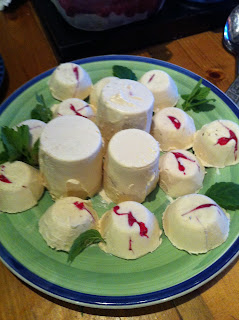This is an absolute must each year and a real indication that the summer fruit is here. I normally just wing it with the mix of fruit and sugar, depending on what I have and how sweet the fruit is, but here is a Nigel Slater recipe, which is really comprehensive.
850g mixed raspberries and currants, with an emphasis on raspberries
7-8 slices firm, good quality white bread
3 tbsps white sugar
3 tbsps water
cream to serve
Sort through the fruit, tenderly, picking out any that are unripe or mouldy. There's nearly always a few. Pull the currants from their stems then put them, with the raspberries, in a stainless-steel saucepan over a low heat. Taste the fruit for sweetness and add sugar accordingly. For normal, sweet raspberries and slightly tart currants, I add 3 tablespoons or so of sugar. Sometimes you may need slightly less or more. Use your own judgment, bearing in mind that the finished pudding should have a bit of sharpness to it. Pour in a little water, a couple of tablespoons will do, then bring it to the boil.
The currants will start to burst and give out their juice. They need no longer than three or four minutes at a cautious simmer. The fruit should be shiny and there should be much magenta juice in the pan. Turn off the heat.
Slice the bread thickly. Each slice should be about as thick as your little finger. (Thinner if you are making several smaller puddings in individual moulds.) Cut the crusts off the bread. Set one piece aside, then cut the rest into 'soldiers', that is, each slice of bread into three long fingers. Using a glass or cup as a template, cut a disc of bread from the reserved slice and push it into the bottom of the pudding basin.
Line the inside of the basin with the strips of bread, pushing them together snugly so that no fruit can escape, and keeping a few strips for the top. Fill the bread-lined basin with the fruit and its juice - it should come almost to the rim. Lay the remaining bread on top of the fruit, tearing and patching where necessary, so no fruit is showing.
Put the basin in a shallow dish or bowl to catch any juice, then lay a flat plate or small tray on top with a heavy weight to squash the fruit down. Some juice may escape, but most will soak into the bread. Leave overnight in the fridge. (You may have to remove a shelf depending on how deep your fridge shelves are.)
Remove the weights, slide a palette knife around the edge, pushing carefully down between bread and basin so as not to tear the bread. Put a plate on top, and then, holding the plate in place, turn quickly upside down and shake firmly to dislodge the pud. It should slide out and sit proud. Pass a jug of cream around - it is an essential part of the pudding. Serves 6-8.


































